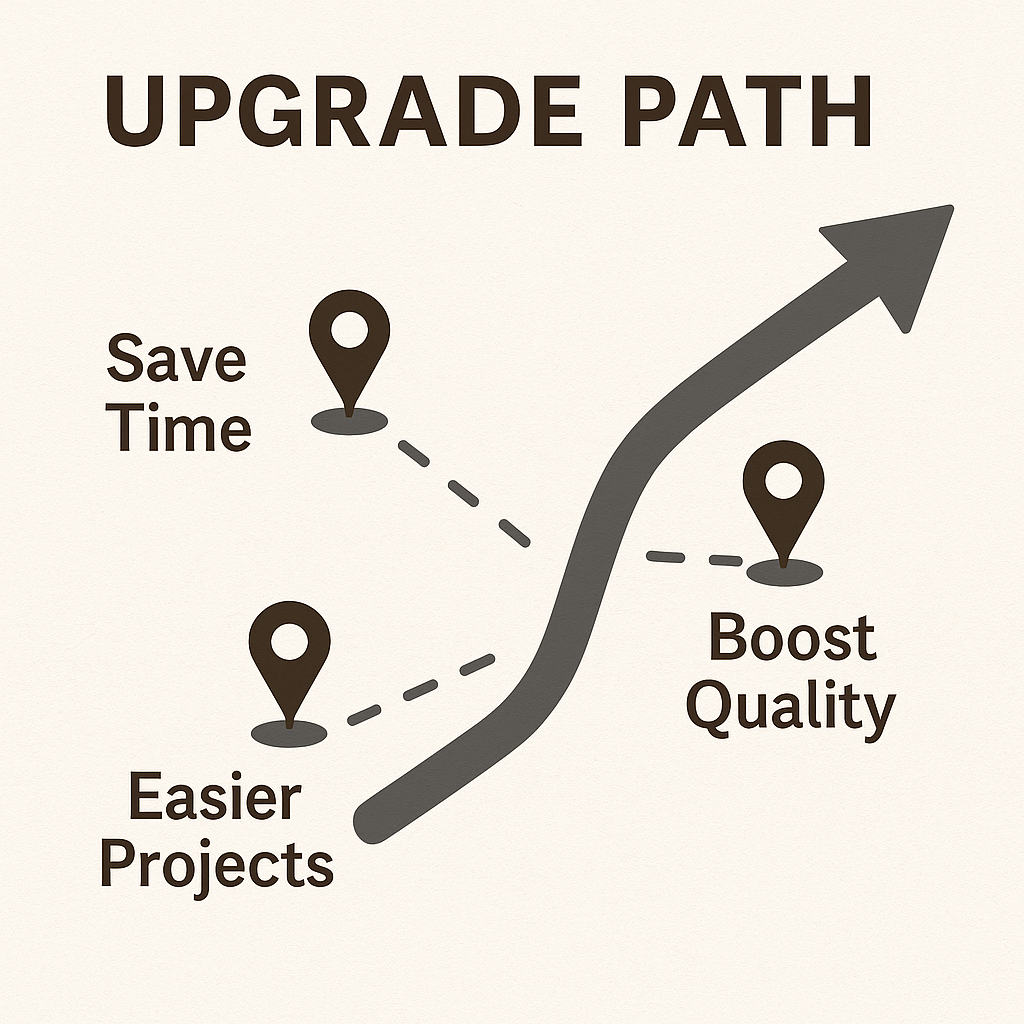You’ve patched drywall, laid some flooring, maybe built a bench or installed trim. Your basic tool kit has served you well—but it’s starting to feel… basic.
If you’re ready to work faster, cleaner, and with better results, here’s the DIY tool upgrade path we recommend. These are the tools that will grow with your projects and flat-out make your weekends easier.
📈 Signs It’s Time to Upgrade
- You’re recharging your one drill mid-project
- Your hand saw is slowing down your workflow
- You’re working on bigger, more frequent DIY projects
- You’re noticing the limits of your bargain tools
- You want gear that feels reliable every time you pick it up
🛠️ DIY Tool Upgrade Path (In Order)
1. Oscillating Multi-Tool
You might not know you need one—until you have one. From cutting trim and flooring to detail sanding and grout removal, this tool handles the weird jobs nothing else can.
We love the DEWALT 20V Max XR Oscillating Tool—it’s fast, clean, and handles anything from door trim to drywall cutouts.
2. Laser Level
Still using a bubble level and pencil marks? A laser level speeds up layouts for backsplashes, wall frames, cabinets, and more. Once you try one, there’s no going back.
The Bosch Cross-Line Self-Leveling Laser makes getting perfectly straight tile lines and shelf runs a breeze.
3. Brad Nailer
If you’re still hammering nails into baseboards and window trim, you’re working too hard. Brad nailers are fast, precise, and leave a cleaner finish.
The DEWALT 18-Gauge Cordless Brad Nailer has just the right amount of power and zero compressor hassle.
4. Miter Saw
For straight, repeatable cuts on trim, framing, and flooring, nothing beats a good miter saw. It’s a major upgrade from a circular saw when precision counts.
The DEWALT 12-Inch Sliding Compound Miter Saw cuts smooth and square with every pull.
5. Impact Driver
If you’re still driving deck screws with your drill, you’re missing out. An impact driver has more torque, less wrist strain, and makes heavy-duty fasteners feel light.
We like the Makita 18V LXT Impact Driver for its combo of power, control, and battery life.
6. Cordless Shop Vac
As your projects grow, so does the mess. A portable shop vac is your best friend for keeping workspaces clean—especially around drywall, sawdust, or flooring jobs.
The DEWALT 20V Cordless Wet/Dry Vac is compact, powerful, and fits in tight corners.
7. Battery Upgrade (Optional—but Highly Recommended)
You’ve got the tools. But if you’re still running on 2.0Ah starter batteries, you’re leaving power—and productivity—on the table.
We like the DEWALT 20V MAX* 6.0Ah FLEXVOLT Batteries (2-Pack). They last noticeably longer, pack more torque into heavy tools, and work across both 20V and 60V platforms. More power, fewer swaps, better workflow.
An upgraded battery setup means:
- Less downtime between charges
- Smoother performance for saws, vacs, and nailers
- Longer lifespan with fewer recharge cycles
It’s not a must-have, but if you’re upgrading tools… this completes the package.
⚠️ What to Skip (For Now)
Some tools are great… just not yet. Here’s what can wait:
- Table saw – only needed for serious woodworkers
- Router – useful, but not essential for most weekend projects
- Specialty cordless tools – multi-head kits, palm nailers, etc.
💡 What We’d Buy Again in a Heartbeat
After hundreds of hours of projects, here’s what we’d pick all over again:
- A solid oscillating tool for every “weird” cut
- A laser level for speed and accuracy
- A cordless brad nailer for finish projects
- A miter saw that just works, every time

